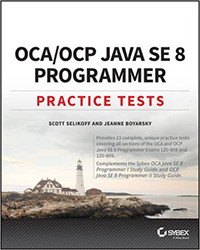It’s been a fun 8 Nights of Java, but alas, tonight is the final post. Java 8 added one of the most radical, most drastic changes to date, even bigger than Java 5 or Java 7: lambdas and streams! The writers of Java updated nearly every Java API to include lambda expression and stream-based methods. More than the API changes, though, they present a new paradigm for thinking about programming. The closest thing to a lambda expression prior to Java 8 was an anonymous inner class, and it a lot of ways they are similar, but the syntax and usability of lambda expressions is unmatched.
We hope everyone had a wonderful holiday season and we hope that you have a Happy New Year! Don’t forget, we have a brand new OCA/OCP 8 book coming out in March 2017. Order yours now on Amazon.com!
Java 8 Notable Features
Oracle released Java 8 on March 18, 2014. If you’ve read the previous nights in this series, you might be wondering what the codename of Java 8 was. Oracle decided not to use one. Luckily, our friends at the Javaranch had some ideas. We like “Cuddles” ourselves.
Key new functionality included:
- Functional interfaces
- Lambda expressions
- Streams
- New date/time library
- Project Nashorn
From Jeanne:
Streams and lambdas are one of my favorite additions to the language of all time. They make it easy to write expressive code. I haven’t needed the benefits of multi-core parallelization much yet, but it is nice to know it is there. Even without that, I find my stream based code to be shorter and easy to write/read. It took me a little while to get fluent but I went through that with Groovy before Java so I was ready when it came to Java. I was the first person on my team to write a Java 8 program for work. I commented almost every line so it could be used as a teaching example. That was fun!
The date/time library is also cool. I like that it is expressive and has so much more functionality than the Calendar API. Third time for a date API really was the charm. I just wish they retrofitted it to work directly with more libraries like JDBC. Then there’s Nashorn. A JavaScript console was a good idea, but I don’t think this one is it.
From Scott:
Two things I love about lambda expressions and streams in Java 8. First, they found a way to build functional programming into Java, by using functional interfaces. While the signature for some of the built-in functional interfaces can be… hard to read… using or creating lambda expressions rarely requires understanding the signature. That’s what is so cool about what they did. They added this conversion of lambda expressions to functional interfaces to anonymous inner classes, but from a developers perspective, all we have to know how to do is write a simple one-line lambda expression! Very cool they way they added this on without breaking the language.
The second thing I love is they included parallel streams in the very first version! It’s so awesome to be able to have built-in easy support for concurrency without having to create/manage/shutdown an executor service. One feature request for Java 9? I *really* would prefer a way to set the number of threads in a parallel stream, such as stream.parallel(10) for 10 threads. Currently, it’s controlled by the JVM based on the number of threads on the computer and unable to be changed by a developer. Here’s hoping they add it to a future version of Java!
There’s still so much more to love about Java 8! As I was saying on Night 7, Java 7 improved the Concurrency API while introducing NIO.2, but both became even more powerful in Java 8. Creating Runnable and Callable instances using anonymous inner classes was already common prior to Java 8, but it was at times verbose. You had to create a class definition, override a method, set up a generic return type for Callable, etc. While not difficult to do, it did take up multiple lines of bloated code, copied over and over again for each task. Lambda expressions fit perfectly in the Concurrency API, better than any other API (with the possible exception of Collections), in that it allowed developers to submit tasks to a thread executor in a single, simple line of code using a lambda expression. In other words, they made Concurrency, one of the arguably most difficult spaces for developers to work in, much easier to understand and implement.


